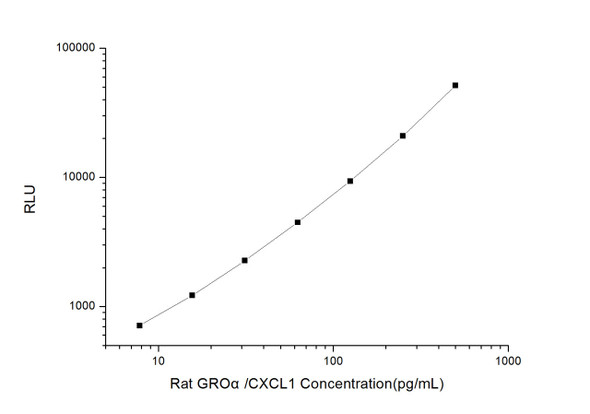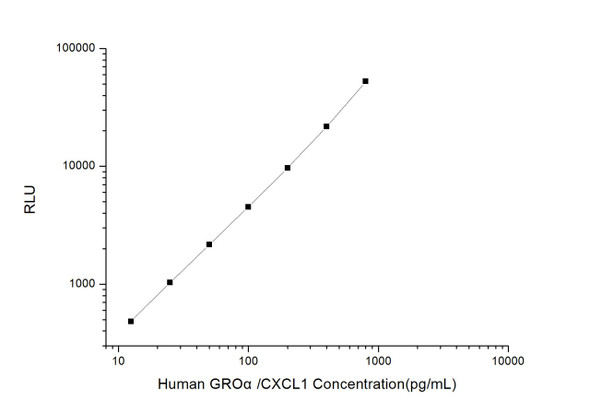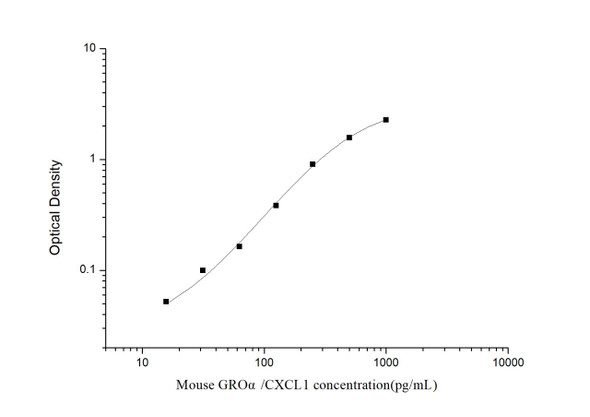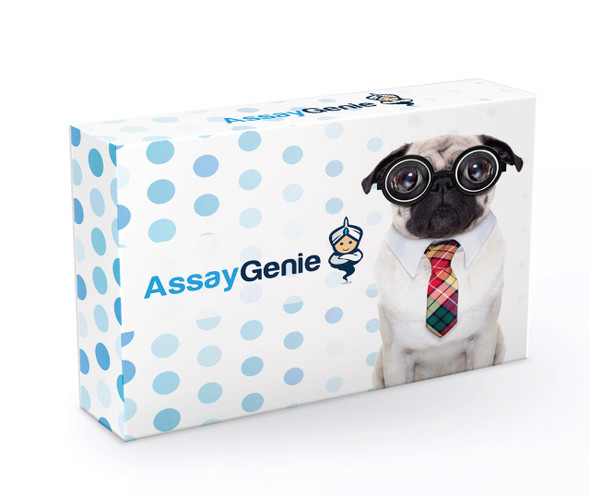Mouse Immunology ELISA Kits
Mouse GRO alpha/CXCL1 (Growth Regulated Oncogene Alpha) CLIA Kit (MOES00016)
- SKU:
- MOES00016
- Product Type:
- ELISA Kit
- ELISA Type:
- CLIA Kit
- Size:
- 96 Assays
- Sensitivity:
- 4.69pg/mL
- Range:
- 7.81-500pg/mL
- ELISA Type:
- Sandwich
- Synonyms:
- NAP3, GRO1, GRO-A, MGSA, MGSA-A, SCYB1, FSP, CINC-1
- Reactivity:
- Mouse
- Sample Type:
- Serum, plasma and other biological fluids
- Research Area:
- Immunology
Description
| Assay type: | Sandwich |
| Format: | 96T |
| Assay time: | 4.5h |
| Reactivity: | Mouse |
| Detection method: | Chemiluminescence |
| Detection range: | 7.81-500 pg/mL |
| Sensitivity: | 4.69 pg/mL |
| Sample volume: | 100µL |
| Sample type: | Serum, plasma and other biological fluids |
| Repeatability: | CV < 15% |
| Specificity: | This kit recognizes Mouse GRO alpha/CXCL1 in samples. No significant cross-reactivity or interference between Mouse GRO alpha/CXCL1 and analogues was observed. |
This kit uses Sandwich-CLIA as the method. The micro CLIA plate provided in this kit has been pre-coated with an antibody specific to Mouse GRO alpha/CXCL1. Standards or samples are added to the appropriate micro CLIA plate wells and combined with the specific antibody. Then a biotinylated detection antibody specific for Mouse GRO alpha/CXCL1 and Avidin-Horseradish Peroxidase (HRP) conjugate are added to each micro plate well successively and incubated. Free components are washed away. The substrate solution is added to each well. Only those wells that contain Mouse GRO alpha/CXCL1, biotinylated detection antibody and Avidin-HRP conjugate will appear fluorescence. The Relative light unit (RLU) value is measured spectrophotometrically by the Chemiluminescence immunoassay analyzer. The RLU value is positively associated with the concentration of Mouse GRO alpha/CXCL1. The concentration of Mouse GRO alpha/CXCL1 in the samples can be calculated by comparing the RLU of the samples to the standard curve.
| UniProt Protein Function: | CXCL2: Produced by activated monocytes and neutrophils and expressed at sites of inflammation. Hematoregulatory chemokine, which, in vitro, suppresses hematopoietic progenitor cell proliferation. GRO-beta(5-73) shows a highly enhanced hematopoietic activity. Belongs to the intercrine alpha (chemokine CxC) family. |
| UniProt Protein Details: | Protein type:Secreted; Motility/polarity/chemotaxis; Secreted, signal peptide Cellular Component: extracellular space; cell; extracellular region; cytosol Molecular Function:growth factor activity; chemokine activity; CXCR chemokine receptor binding; cytokine activity Biological Process: neutrophil chemotaxis; G-protein coupled receptor protein signaling pathway; elevation of cytosolic calcium ion concentration; response to molecule of bacterial origin; positive regulation of superoxide release; positive regulation of potassium ion transport; response to lipopolysaccharide; immune response; positive regulation of leukocyte chemotaxis; inflammatory response; acute inflammatory response; regulation of cell proliferation |
| NCBI Summary: | This gene encodes a protein that is a member of the CXC subfamily of chemokines. Chemokines, which recruit and activate leukocytes, are classified by function (inflammatory or homeostatic) or by structure. This secretory protein is proposed to bind the G-protein coupled receptor chemokine (C-X-C motif) receptor 2 to recruit neutrophils. In mouse, deficiency of this gene is associated with colitis and with defects in immune cell recruitment to the lung. [provided by RefSeq, Apr 2013] |
| UniProt Code: | P12850 |
| NCBI GenInfo Identifier: | 121623 |
| NCBI Gene ID: | 14825 |
| NCBI Accession: | P12850. 1 |
| UniProt Related Accession: | P12850 |
| Molecular Weight: | 10,254 Da |
| NCBI Full Name: | Growth-regulated alpha protein |
| NCBI Synonym Full Names: | chemokine (C-X-C motif) ligand 1 |
| NCBI Official Symbol: | Cxcl1 |
| NCBI Official Synonym Symbols: | KC; Fsp; N51; gro; Gro1; Mgsa; Scyb1 |
| NCBI Protein Information: | growth-regulated alpha protein; KC/GR)-alpha; KC/GRO-alpha; GRO1 oncogene; alpha-chemokine; secretory protein N51; C-X-C motif chemokine 1; platelet-derived growth factor-inducible protein KC |
| UniProt Protein Name: | Growth-regulated alpha protein |
| UniProt Synonym Protein Names: | C-X-C motif chemokine 1; Platelet-derived growth factor-inducible protein KC; Secretory protein N51Cleaved into the following chain:KC(5-72)Alternative name(s):Hematopoietic synergistic factor; HSF; KC-T |
| Protein Family: | KCNQ1 downstream neighbor protein |
| UniProt Gene Name: | Cxcl1 |
| UniProt Entry Name: | GROA_MOUSE |
As the RLU values of the standard curve may vary according to the conditions of the actual assay performance (e. g. operator, pipetting technique, washing technique or temperature effects), the operator should establish a standard curve for each test. Typical standard curve and data is provided below for reference only.
| Concentration (pg/mL) | RLU | Average | Corrected |
| 500 | 48636 54438 | 51537 | 51508 |
| 250 | 20085 21911 | 20998 | 20969 |
| 125 | 10024 8768 | 9396 | 9367 |
| 62.5 | 4258 4766 | 4512 | 4483 |
| 31.25 | 2357 2241 | 2299 | 2270 |
| 15.63 | 1262 1238 | 1250 | 1221 |
| 7.81 | 735 745 | 740 | 711 |
| 0 | 28 30 | 29 | -- |
Precision
Intra-assay Precision (Precision within an assay): 3 samples with low, mid range and high level Mouse GRO alpha/CXCL1 were tested 20 times on one plate, respectively.
Inter-assay Precision (Precision between assays): 3 samples with low, mid range and high level Mouse GRO alpha/CXCL1 were tested on 3 different plates, 20 replicates in each plate.
| Intra-assay Precision | Inter-assay Precision | |||||
| Sample | 1 | 2 | 3 | 1 | 2 | 3 |
| n | 20 | 20 | 20 | 20 | 20 | 20 |
| Mean (pg/mL) | 23.43 | 71.10 | 222.79 | 25.36 | 69.65 | 209.34 |
| Standard deviation | 2.68 | 7.60 | 22.55 | 2.72 | 5.20 | 16.16 |
| C V (%) | 11.44 | 10.69 | 10.12 | 10.73 | 7.47 | 7.72 |
Recovery
The recovery of Mouse GRO alpha/CXCL1 spiked at three different levels in samples throughout the range of the assay was evaluated in various matrices.
| Sample Type | Range (%) | Average Recovery (%) |
| Serum (n=5) | 92-110 | 100 |
| EDTA plasma (n=5) | 91-107 | 97 |
| Cell culture media (n=5) | 91-102 | 97 |
Linearity
Samples were spiked with high concentrations of Mouse GRO alpha/CXCL1 and diluted with Reference Standard & Sample Diluent to produce samples with values within the range of the assay.
| Serum (n=5) | EDTA plasma (n=5) | Cell culture media (n=5) | ||
| 1:2 | Range (%) | 101-118 | 87-98 | 101-117 |
| Average (%) | 108 | 92 | 108 | |
| 1:4 | Range (%) | 94-110 | 100-116 | 89-99 |
| Average (%) | 100 | 107 | 94 | |
| 1:8 | Range (%) | 100-115 | 91-107 | 93-106 |
| Average (%) | 106 | 98 | 99 | |
| 1:16 | Range (%) | 85-97 | 100-118 | 104-121 |
| Average (%) | 91 | 108 | 110 |
An unopened kit can be stored at 4°C for 1 month. If the kit is not used within 1 month, store the items separately according to the following conditions once the kit is received.
| Item | Specifications | Storage |
| Micro CLIA Plate(Dismountable) | 8 wells ×12 strips | -20°C, 6 months |
| Reference Standard | 2 vials | |
| Concentrated Biotinylated Detection Ab (100×) | 1 vial, 120 µL | |
| Concentrated HRP Conjugate (100×) | 1 vial, 120 µL | -20°C(shading light), 6 months |
| Reference Standard & Sample Diluent | 1 vial, 20 mL | 4°C, 6 months |
| Biotinylated Detection Ab Diluent | 1 vial, 14 mL | |
| HRP Conjugate Diluent | 1 vial, 14 mL | |
| Concentrated Wash Buffer (25×) | 1 vial, 30 mL | |
| Substrate Reagent A | 1 vial, 5 mL | 4°C (shading light) |
| Substrate Reagent B | 1 vial, 5 mL | 4°C (shading light) |
| Plate Sealer | 5 pieces | |
| Product Description | 1 copy | |
| Certificate of Analysis | 1 copy |
- Set standard, test sample and control (zero) wells on the pre-coated plate and record theirpositions. It is recommended to measure each standard and sample in duplicate. Note: addall solutions to the bottom of the plate wells while avoiding contact with the well walls. Ensuresolutions do not foam when adding to the wells.
- Aliquot 100 µL of standard solutions into the standard wells.
- Add 100 µL of Sample / Standard dilution buffer into the control (zero) well.
- Add 100 µL of properly diluted sample (serum, plasma, tissue homogenates and otherbiological fluids. ) into test sample wells.
- Cover the plate with the sealer provided in the kit and incubate for 90 min at 37 °C.
- Aspirate the liquid from each well, do not wash. Immediately add 100 µL of BiotinylatedDetection Ab working solution to each well. Cover the plate with a plate seal and gently mix. Incubate for 1 hour at 37 °C.
- Aspirate or decant the solution from the plate and add 350 µL of wash buffer to each welland incubate for 1-2 minutes at room temperature. Aspirate the solution from each well andclap the plate on absorbent filter paper to dry. Repeat this process 3 times. Note: a microplatewasher can be used in this step and other wash steps.
- Add 100 µL of HRP Conjugate working solution to each well. Cover with a plate seal andincubate for 30 min at 37 °C.
- Aspirate or decant the solution from each well. Repeat the wash process for five times asconducted in step 7.
- Add 100 µL of Substrate mixture solution to each well. Cover with a new plate seal andincubate for no more than 5 min at 37 °C. Protect the plate from light.
- Determine the RLU value of each well immediately.






